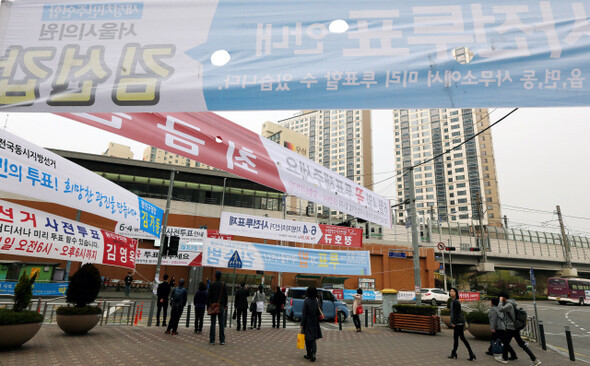A publicity rollout encouraging preliminary voting by preliminary candidates running for the 2014 June 4 local elections is hung on the crossing in front of Gangbyeon Station in Guui-dong, Gwangjin-gu, Seoul on the day of the 10th. Senior Reporter Kang Jae-hoon [email protected]
Whenever an election is held, a lot of waste such as banners, publications, posters, shoulder straps, and vests comes out. Among them, banners made of plastic materials are particularly troublesome because they do not rot, and when burned, they emit harmful substances. Even during the 4·7 re-election, when the banner election campaign is possible starting on the 25th, voices are coming out to hold the election without a banner. Recently, the Environmental Organization’s Solidarity for Resource Recycling Society issued a statement and suggested’exercise not to write banners’ to candidates for the 4-7 re-election. The Solidarity of Resource Circulation Society said, “With the spread of plastic-free campaigns around the world, the use of banners to promote elections must now be changed. “It’s a shame to create a lung placard.” When the election is over, the publicity banners of candidates placed across the country become tens of thousands of waste. According to the Public Official Election Act, each candidate may post a banner up to twice the number of eups, myeons, and dongs within the constituency for election campaigns. You can attach one banner. Based on this regulation, the Solidarity for Resource Recycling Society predicts that 12,720 closed banners will occur in 424 dongs in Seoul, assuming that 10 candidates for the mayor of Seoul will be in the final election in this election. In the 2018 local election, there were 130,000 closed banners. Most of these banners are made of plastic, so they do not rot even when buried, and pollutants such as carbon dioxide are generated when incinerated.
Green Party banner on the street in front of Express Bus Terminal Station in Seocho-gu, Seoul during the Lunar New Year holiday in February. The Republican Party hung 6-7 banners, and the Green Party hung 1 banner. The Green Party on the 18th <한겨레>“For a few political parties that have a limited financial situation, the way of communicating with the banner is still a cost-effective means of publicity,” he confessed to his practical concerns. By Choi Woo-ri, staff reporter
There are concerns that it is difficult to give up the banner right away from the standpoint of a party that needs to inform the candidate even a little more. In particular, for a small number of political parties with weak capital and hard to find contact with citizens, the banner is still a good publicity tool for’cost performance’ (price/performance). Even the Green Party, which puts ecology and the environment first, has put up a banner to communicate with citizens during the Lunar New Year holidays. Lee Eun-ho, chairman of the Green Party Climate Justice Committee, said, “Since it is a small number of parties, more candidates must be known, but financial burdens increase to promote digitally. There were times when all publications were not distributed across the country due to price problems. On the other hand, a banner is a way to stand out once you make it neatly and hang it. It is difficult not to use it at all,” he said. “However, we are minimizing the production of banners and recycling them through companies that make bags out of waste banners. Also, I try to use it repeatedly because I don’t write the date on the banner as much as possible.”
A banner bag sold at Touch for Good. Touch for Good website capture
There are also efforts to up-cycling instead of throwing away banners, but it is not enough to reduce waste generation. ‘Touch for Good’, a social enterprise, started upcycling the election banner during the 2010 Superintendent’s election, and produced and sold eco-bags containing the pledges of the candidates in the 18th and 19th presidential elections. “When we first proposed recycling in 2010, the banners sent from each candidate camp were carried by truck, so we couldn’t put them all in the office,” said Mi-Hyun Park, CEO of Touch for Good. Ten years have passed, but nothing has changed.” “To hold an eco-friendly election, you have to do less flashy publicity, but it is impossible in the election competition. Other candidates posted banners, but I can’t do it alone,” he said. He said, “We must come out at the level of the Central Election Commission. He stressed that the election committee and the party’s election officers and experts should go head-to-head.” The NEC is in a position that it is difficult to recommend that the banner be not used right away, as there are regulations in the Public Official Election Act on the posting of banners. In a phone call with the NEC, “the current Public Official Election Act Article 67 is regulated to post a banner in each region.” “A matter to be decided by legislation and policy considering the expansion of freedom of the election movement, urban aesthetics, environmental issues, etc. I said. By Kim Min-je, staff reporter
newsletter
Every morning, every Thursday day
A friendly newsletter that will save you from the flood of news.
Meet
